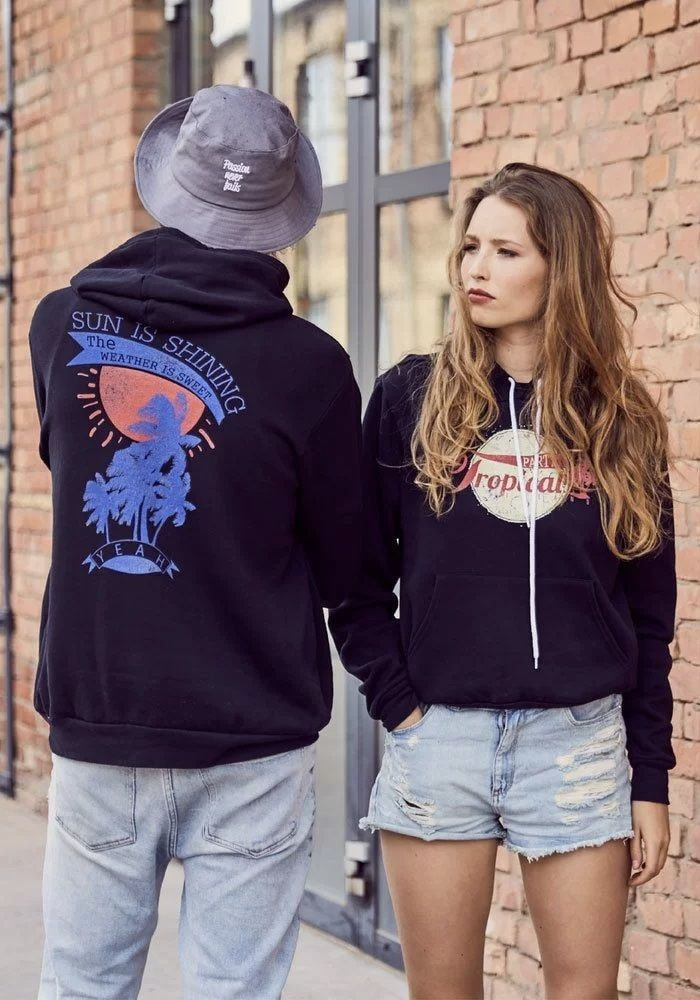Launching a clothing brand is an exciting adventure, but success lies in the details. One of the most important elements of a thriving online business is efficient shipping. If you get it right, you’ll save money and boost your profits – and that’s especially true when it comes to shipping your popular hoodie designs.
Hoodies are one of the most coveted items in fashion today. They’re versatile, cozy, and perfect for the colder months, making them a great gift option or wardrobe staple for your customers. But here’s the catch: the weight of your hoodie plays a far more significant role in shipping costs than you might think.
It’s not just about knowing how much your hoodie weighs—it’s about understanding how fabric choices, design features, and even packaging all impact the total weight and, ultimately, your shipping expenses.
In this article, we’ll break down everything you need to know about hoodie weight and how it affects your bottom line. By the end, you’ll be able to answer the all-important question: How much does a hoodie weigh? and how to manage it for cost-effective shipping.
How much does an average hoodie weigh?
Let’s start with the basics. When presenting the weight of a hoodie in your online store, it’s best to provide the measurement in both grams and ounces to accommodate international markets. 1 gram = 0.035274 ounces. Depending on the material, the average hoodie weighs anywhere between 340 and 450 grams (or roughly 12 and 16 ounces). The weight of custom hoodies can vary beyond these limits, depending on the material and design.
Since the margin is so wide, hoodies can be divided into three broad categories: lightweight hoodies, medium hoodies, and heavyweight hoodies. Each one has its own advantages. So when you’re brainstorming different hoodie design ideas, it’s best to get acquainted with the pros and cons of all three categories, so you can offer your customers the most suitable one.
One of the main factors to consider in regard to hoodie weight is GSM or grams per square meter. This refers to the general density of the fabric: how much it weighs relative to its size. GSM is usually determined by the primary fabric, but can include other factors as well.
Lightweight hoodies average up to 280 g/m², medium-weight hoodies average anywhere between 280 and 350 g/m², and heavyweight hoodies will weigh 350 g/m² and beyond.
Alternatively, there is oz/yd² or ounces per yard squared. By converting the measurement from GSM, we see that lightweight hoodies average up to 8.258 oz/yd², medium hoodies average between 8.258 oz/yd² and 10.322 oz/yd², and anything beyond 10.322 oz/yd² is considered heavyweight.
It’s also important to understand singles. Single is a term that refers to the diameter of a yarn, determined by the number of times you twist the fiber. The higher the single, the finer the yarn and the softer the resulting garment. You might have heard of the term ‘thread count’, and these are similar terms, however ‘thread count’ is used in reference to bed sheets, while singles are used in reference to clothes.
Now that we have a basic grasp of the terminology, let’s take a look at the different weight categories of hoodies, and what each of them can offer your customers.


@media (max-width:768px) {
.pf-btn-lg { height: 40px; line-height: 38px; min-width: 88px; font-size: 16px; }
}
Lightweight hoodies
The main advantages of this category are breathability and increased range of motion, making them ideal for customers who enjoy a more active lifestyle. To achieve a lighter weight, it’s often necessary to mix cotton with a polyester blend. This also makes lightweight hoodies very soft to the touch. The lighter material means a lighter average weight.
Unisex Pullover Hoodie | Bella + Canvas 3719
This hoodie, made from 52% airlume combed ring-spun cotton and 48% poly fleece, demonstrates the benefits of lightweight hoodies perfectly. Weighing in at 220.4 g/m² (6.5 oz/yd²), this hoodie is incredibly soft to the touch, thanks to the poly fleece lining. This makes it comfortable and cozy for your potential customers.
Medium hoodies
Most adult-sized hoodies will fall into this category, their main advantage being budget-friendly materials. You will also often find a lot of sweatshirts in this weight category for roughly the same reason.
Cotton is the most common material, but it’s still often combined with synthetic materials like polyester. This also makes them the best quality hoodies for printing. Popular brands frequently opt for medium-weight hoodies, a choice that resonates with a diverse customer base and contributes to their widespread popularity.
Unisex Premium Hoodie | Cotton Heritage M2580
This hoodie, with a front pouch pocket and matching flat drawstrings, is a Printful bestseller. Made from 65% ring-spun cotton and 35% polyester, it weighs in at 288.2 g/m² (8.5 oz./yd.²), placing it on the lighter side of the medium weight category. It also offers lots of customization options, such as putting your logo on the custom inside label.
Heavyweight hoodies
Because these kinds of hoodies tend to use thicker fabrics, like heavyweight cotton, fleece, or wool blends, they offer much more warmth and insulation, making them ideal for colder climates. They also tend to be more durable, offering better value for money to your customers. You can also spot the occasional sweatshirt in this category.
Unisex Essential Eco Hoodie | Stanley/Stella STSU822
This hoodie, made from 85% organic ring-spun combed cotton and 15% recycled polyester produced from recycled plastic bottles, offers a thicker, warmer, more eco-friendly option. The double-layered hood offers more warmth and protection to the neck and head.
Other components
When calculating hoodie weight, the fabric itself isn’t the only factor. Some hoodies have a front-pouch pocket, which uses more fabric. Some hoodies have a zipper down the middle, which slightly increases the weight if it’s made of plastic, and considerably more if it’s made of metal. Additionally, heavy embroidery or other decors like rhinestones or drawstrings with metal toggles, can add weight as well.
Even the amount of paint that’s added to the hoodie through direct-to-garment printing can play a factor in its total weight. Paying attention to these details may seem trivial at first, but when you start shipping in bulk, even a small difference in weight, measured in milligrams, can translate into huge shipping cost savings down the line.


@media (max-width:768px) {
.pf-btn-lg { height: 40px; line-height: 38px; min-width: 88px; font-size: 16px; }
}
Packaging materials
When shipping any kind of clothing, it’s important to consider the weight of not just the clothes themselves, but the packaging materials as well. The extra weight they might add to the total weight of the package can seriously affect your shipping costs. Even minor adjustments in material selection or packaging approach can lead to substantial savings.
When planning to package your clothing items, it’s recommended that you weigh the packaging separately from the article of clothing, to see exactly how much it adds to the total weight.
Sounds like quite a lot of steps. The good news? If you team up with a print-on-demand partner Printful, we’ll print, pack, and ship your custom hoodie designs to your customers for you. We offer fixed hoodie shipping rates that you can check before ordering, so there’s no need to worry about weighing your parcels and getting the shipping rates right every time.
Conclusion
So, how much does a hoodie really weigh? The answer isn’t as simple as you might think—it all depends on a variety of factors like fabric, design, and even packaging. While this guide has only scratched the surface of the many variables that influence hoodie weight and shipping costs, we hope it’s given you a clearer understanding of how to navigate these details.
As you continue building your brand, whether you’re working with fleece, cotton, or polyester, you’ll be better equipped to make smarter decisions that balance quality and cost-efficiency. With the right knowledge, you can deliver high-quality trending hoodies to your customers without breaking the bank on shipping. Happy selling!








